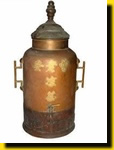|
Exhibition of Intangible Cultural Heritage in China
Thematic Galleries (1) & (2),
Hong Kong Heritage Museum 21 December 2008 - 16 February 2009
Jointly presented by the Bureau of Hong Kong, Macao and Taiwan Cultural Affairs, Ministry of Culture, and the Leisure and Cultural Services Department, and organised by the Center for Ethnic and Folk Literature and Art Development, Ministry of Culture, the Chinese National Museum of Ethnology and the Hong Kong Heritage Museum, the Exhibition of Intangible Cultural Heritage in China will run from 21 December 2008 to 16 February 2009 and, through 326 pictures, 102 artefacts as well as a series of demonstrations by heritage bearers who have preserved the traditions of craftsmanship, offer audiences an insight into the forms and expressions of China's intangible cultural heritage.
Showcasing ballads, proverbs, songs, dance, acrobatics, opera, quyi, folk art, folklore, rituals, handicraft, traditional Chinese medicine and much else besides, the diverse and comprehensive content of the exhibition covers almost every aspect of Chinese people's lives. Highlights include the ancient characters of the Shui people that reveal the unique written symbol system of the clan; Tibetan surgical tools which demonstrate the masterly skills of Tibetan medicine; Uyghur Muquam musical instruments that introduce to us the fantastic soundscape of ethnic music; the dragon design adorning textiles of the Li people that bears an important meaning in ritual ceremonies and displays the highly intricate workmanship of the four crafts of the Li people (spinning, weaving, dyeing and embroidery); and cloud-pattern brocade, which presents the eternal charm of the unique floral pattern and weaving skills originating in Nanjing. The skills of Chinese craftsmen and the delicacy of their designs are also on show in such exquisite handiworks as Liaoqi glassware from Beijing, Tang's dough sculpture, and a straw model of an Imperial Palace watchtower with a screen accentuated by intricate inlay details. Costumes of Cantonese opera and scenes from Beijing opera demonstrate the broad and profound cultural connotations of traditional Chinese opera. The exhibition makes use of information technology, including database, GIS and Flash functions, to provide visitors with exciting new possibilities for interaction. With just a click of the mouse, visitors can watch or listen to exhibits featuring the traditional music of Chinese folk culture, Chinese lunar time, a folk culture map and even try out the paper-cutting game! In addition, masters of traditional folk arts have been invited to present live performances during the opening week from 21 December to 26 December 2008. They include Tang Suguo, heir to the traditions of Tang's dough sculpture; Wan Zi, who succeeds the Beijing gold lacquer inlay technique; Wang Haili, disciple of the interior painting of the Ji (Hebei) School; Liu Xing, disciple of Beijing Liaoqi glassware; Liu Guosheng, who continues the traditions of the Wuqiang new year paintings; and Wang Wending, who continues the traditions of palm plaiting, as well as a master from the Cloud-pattern Brocade Institute of Nanjing. What's more, a number of artists will attend the exhibition, while a Tangshan Shadow Play will be performed between 30 January and 2 February 2009 during the Lunar New Year. Exhibit Highlights
Other Past Exhibitions |
||||||||||||||||||||||||



